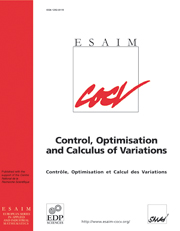Crossref Citations
This article has been cited by the following publications. This list is generated based on data provided by
Crossref.
Abdelwahed, M.
Hassine, M.
and
Masmoudi, M.
2009.
Optimal shape design for fluid flow using topological perturbation technique.
Journal of Mathematical Analysis and Applications,
Vol. 356,
Issue. 2,
p.
548.
Larnier, Stanislas
and
Masmoudi, Mohamed
2013.
The extended adjoint method.
ESAIM: Mathematical Modelling and Numerical Analysis,
Vol. 47,
Issue. 1,
p.
83.
N. Sá, L. F.
R. Amigo, R. C.
Novotny, A. A.
and
N. Silva, E. C.
2016.
Topological derivatives applied to fluid flow channel design optimization problems.
Structural and Multidisciplinary Optimization,
Vol. 54,
Issue. 2,
p.
249.
N. Sá, L. F.
Novotny, A. A.
Romero, J. S.
and
N. Silva, E. C.
2017.
Design optimization of laminar flow machine rotors based on the topological derivative concept.
Structural and Multidisciplinary Optimization,
Vol. 56,
Issue. 5,
p.
1013.
Hassine, Maatoug
and
Kallel, Imen
2018.
Kohn–Vogelius formulation and topological sensitivity analysis based method for solving geometric inverse problems.
Arab Journal of Mathematical Sciences,
Vol. 24,
Issue. 1,
p.
43.
Novotny, Antonio André
Sokołowski, Jan
and
Żochowski, Antoni
2019.
Topological Derivatives of Shape Functionals. Part II: First-Order Method and Applications.
Journal of Optimization Theory and Applications,
Vol. 180,
Issue. 3,
p.
683.
BenSalah, Mohamed
2022.
Topological Sensitivity Analysis Method in Identifying of Point Sources via Time-Fractional Diffusion Equation.
Acta Applicandae Mathematicae,
Vol. 181,
Issue. 1,
Hassine, Maatoug
and
Ouni, Marwa
2023.
Topological sensitivity analysis for the 3D nonlinear Navier–Stokes equations.
Asymptotic Analysis,
Vol. 135,
Issue. 1-2,
p.
277.
Hassine, Maatoug
and
Chaouch, Sana
2023.
Topological asymptotic expansion for the full Navier–Stokes equations.
Asymptotic Analysis,
Vol. 133,
Issue. 1-2,
p.
91.
Malek, Rakia
Hassine, Maatoug
and
Hrizi, Mourad
2023.
Singular geometry perturbation based method for shape-topology optimization in unsteady Stokes flow.
Journal of Mathematical Analysis and Applications,
Vol. 517,
Issue. 2,
p.
126648.
Abdelwahed, Mohamed
Chorfi, Nejmeddine
and
Hassine, Maatoug
2025.
On the topological gradient method for a nonlinear problem.
Boundary Value Problems,
Vol. 2025,
Issue. 1,
Abdelwahed, Mohamed
Chorfi, Nejmeddine
and
Hassine, Maatoug
2025.
Topological Asymptotic Analysis for a Time Fractional Identification Problem.
Mathematical Methods in the Applied Sciences,
Vol. 48,
Issue. 14,
p.
13530.

